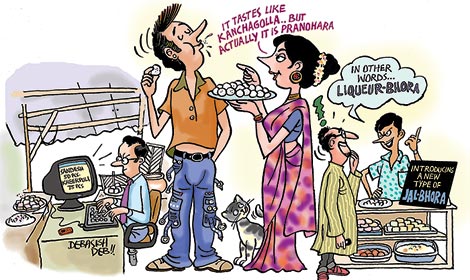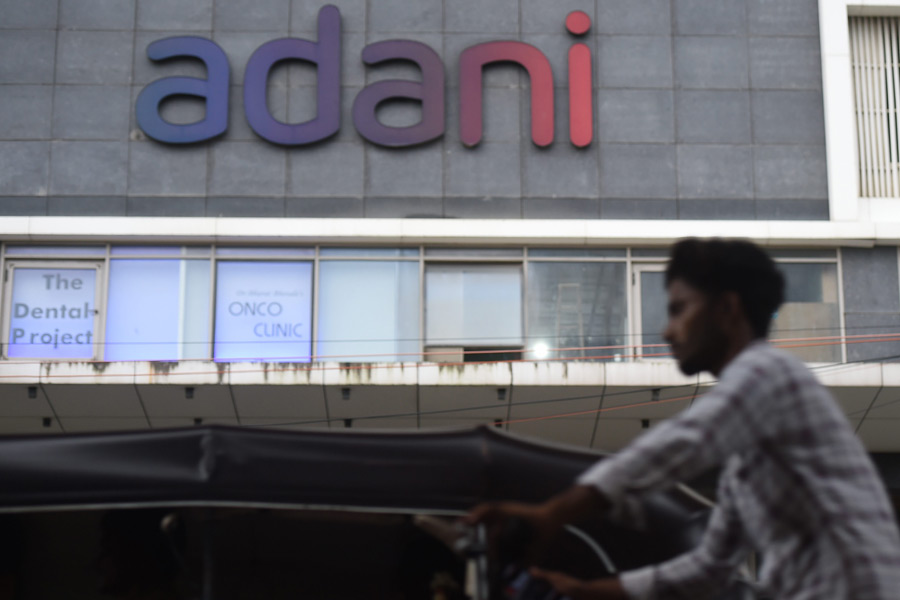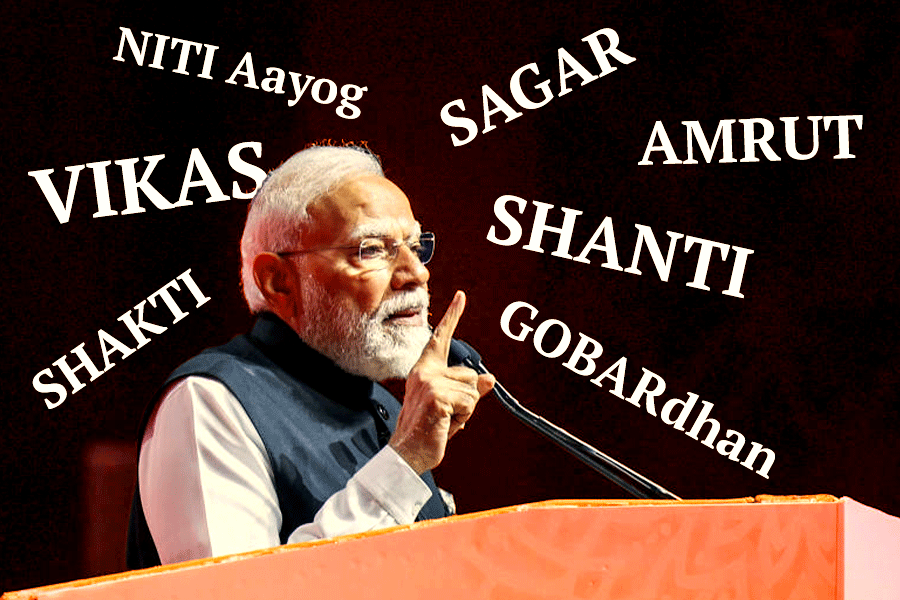 |
Saptami, evening: The hands attached to the bodies milling in and out of pandals grabbing, at regular intervals, egg roll, fish fry, chicken kobiraji, phuchka, cola glasses, ice-cream cones, candifloss sticks. But mishti? Whoever has heard of a sandesh-rasogolla stall at a puja pandal?
Ashtami, morning: A south Calcutta sweet shop, crowded with people noisily demanding “kurita chhanar goja” and “tirishta abar khabo”. The only young face in the crowd is of the boy evidently sent by his master or mistress to fetch sweets for the household.
Nabami, early afternoon: Community lunch in a housing complex. A 20-something, with gelled and spiked hair, shouts: “Kaku, amay aaro duto sandesh…”
Dashami, late night: Empty para mandap. Jethus and jethimas waiting with bonde and pantua for the young boys and girls to come back from the bhashan.
Whatever be the climate, economic, political or meteorological, this is the sweet season of Bengal. However young and cool, you finally fall a victim. Don’t be surprised to find that many Bengalis are less alarmed by the flight of the Tatas from the state — they had known it all along, you see — than by the fact that more and more people are falling prey to diabetes these days. Every mishtanna bhandar worth its rasogolla has a “diabetic-sandesh” in its repertoire. But this is not the time to worry about sugar in your blood or the lack of it in the morning news.
This year, the pujas have been made sweeter for 65-year-old Subhankar Ganguly by the fact that for the first time since he moved from north Calcutta to Golf Green 12 years ago, he could have Nakur Nandy’s sandesh every day. The opening of Nakur’s outlet at the Rashbehari Avenue Spencer’s has marked a revolution of sorts in the world of Bengali sweets, making uprooted Northerners jump for joy, and taking the edge out of the North’s mishti snobbery. It has also shown that the Bengali has been brand-conscious about his sandesh and rasogolla long before he began to wear Levi’s jeans. Of course, there are still people like Sobhanlal Mukherjee who crib that “Nakur’s ethos is so different from everything that Spencer’s stands for”. But if Nakur is a premier brand in Bengali sweets, then what could be a more appropriate destination for it than the newest supermarket chain in the city?
Makhan Lall Das’s shop inside Chitpur’s dingy Nutanbazar, quite like Nakur’s original shop on Ramdulal Sarkar Street, is unimpressive. But it has a well-designed, user-friendly website. Clients can order online or over phone, and the sweets are home-delivered anywhere in Calcutta. Difficult to imagine as it might be, you could as easily get at home Makhan Lall Das’s Rose-cream Sandesh as you do your favourite pepperoni pizza. Where there’s a sweet tooth, there’s a way, or whatever it is that they say.
New kids
The old A-list of mishti still has its pride of place, notably on several “Bengali mishti” communities on Orkut, the social networking site. Among the sweets with the highest drool quotients, according to Orkut’s mishti-lovers, are Bhim Nag’s Paradise Sandesh, Nakur’s Kora-pak, Santosh’s Naram-pak Sandesh, Jadab Das’s Chandrapuli, Sen Mahashay’s Mihidana, Banchharam’s Amriti and Jibe-goja, Chittaranjan’s rasogolla, and Jal-bhora made by Surya Modak in Chandernagore.
But this is also a list high on nostalgia. After all, the driving forces behind Orkut’s “Bengali” communities are almost always located thousands of kilometres away from the Bengali borders.
Missing from the list, therefore, are the mishtis and the shops — younger and mostly with a local presence in the expanding south of Calcutta — that have made their brand presence felt over the last couple of decades. These include Hindustan Sweets in Jadavpur and Gariahat, Kamdhenu in Tollygunge-Jadavpur area, Hara-Gouri and Kalpana on Prince Anwar Shah Road, Mukherjee Sweets in Ballygunge Sridurga in Behala and Suresh in Dhakuria.
Some of them have even managed to impress loyalists of Bhim Nag and Nakur. Anil Mitra, going on 60 but not diabetic and a lover of fried, syrupy sweets like pantua, langcha and chhanar jilipi, has no qualms in declaring that Kamdhenu makes the best langchas in town. Many of these shops have hit the jackpot with traditionally home-made delicacies like patishapta and kheerpuli which working Bengali women have no time to make for their families these days.
GeNext rules
Founding years
|
On the other side of these success stories is the folding up of Jalajog, whose payodhi was given its name by no less a personality than Rabindranath Tagore. This must be one of the rare cases when even the Tagore name has failed to sell in Bengal. There was a time when sweet-makers presented the best of their fare to the leading lights of contemporary society and earned glowing certificates in return. The signatories ranged from Netaji to Uttam Kumar. Today’s stars, most insiders in the trade agree, do not give a damn about the future of the sandesh, and it doesn’t help to know that Shah Rukh Khan’s wife loves kheer kadamba.
Not the stars alone. Traditionally, Bengali sweets have lacked the packaging that is required today to sell anything. That’s why many mishtis now are being reinvented with garnishes never dreamt of. Manohara, an ancient Bengali monda, would have silently disappeared from the mishti map of Bengal, had not Nakur thought up Mango Manohara.
And Young Bengal today is calorie-conscious. Or so say senior citizens. Shantimoy Ganguly watches in dismay as his grandchildren pick up the smallest sandesh or rasogolla from a platter of sweets that he, in his youth, would have taken no more than a few minutes to polish off. The relative swankiness of the Western-style confectionery shops, together with the exotic-sounding names such as truffles and puffs draws the mall-bound youth in ways that the flies and the pungent smell of churning cottage cheese in the mishtir dokan never can.
Keeping the young in the fold is the toughest job, though there are some youngsters who not only eat, live and dream sweets, but can also tell their kanchagolla from their pranohara. Mitil Sen, an undergraduate student, cannot think of the Nabami community lunch at her housing society puja without Sen Mahashay’s mihidana. In Iowa, where he has been studying for the past two years, Saayan Mitra misses Naba Krishna Guin, Bhim Nag, Jayasree and Bhupati Ray. He has now devised a way to get out of this peculiar homesickness. He makes pantua and kalakand in his shared kitchen, either with the help of “mixes” available at his neighbourhood Indian shop or by downloading recipes from the web.
“The young are the hardest to get on board, because they are constantly on the lookout for new experiences,” says Sandip Sen of Sen Mahashay, which has come up with Jayanti and Aparupa, two new varieties of sandesh specially for this Puja. The family-run sweet shops, too, have been finding it difficult to get the younger members of the flock into the trade. Prasanta Nandy of Nakur’s confesses that their expansion plans would have taken wing long ago if they had their sons and nephews entered the business more actively. They have now, and not only at Nakur’s. Partha Nandy of Nakur’s, Romeo Das of Jadab Chandra Das, Bikramjit Ghosh of Banchharam are all young and clued in.
Gur or liqueur?
Young blood means fresh ideas, and the mishti industry could do with some to counter the growing popularity of Western desserts and non-Bengali sweets (though only a few sweet-makers are willing to accept that cakes, pastries and kaju barfis pose a threat to sandesh and rasogolla). Brand placement and diversification are very much on the minds of our new entrepreneurs. Jadab Das is seriously thinking of franchisees, Gupta Brothers has offers from Singapore and Bangladesh which it might consider, and Banchharam has set out to grab the probashi Bangali clientele in Bangalore and Mumbai. Rajesh Gupta of Gupta Brothers is convinced that in striking the right balance between traditional Bengali mishti and north Indian mithai and savoury items lies the key to success.
Bengal football has seen the “diamond system”, and Bengali sweets (and literature) the “Diamonda” — the centerpiece of “Kallol’s five-mix sweetmeats” that Lalmohanbabu insisted that even a kora-pak aficionado like Feluda would appreciate. Some of Diamonda’s real-life counterparts have been Jadab Chandra Das’s Cake Sandesh (complete with icing and frosted decorations), Nakur Nandy’s Kiwifruit Chhanar Payesh, Hindustan Sweets’s Carrot Rasogolla, Gupta Brothers’s Sitaphal Kanchagolla, and the malpoa-based Rasamalancha by KC Das. Imagination meets generations of skill every day in some of the oldest sweet shops of Calcutta, but most of them know better than to fiddle around with their brand ambassador items.
Durga puja is over, but the Bijoya season is on. And Lakshmi puja, Diwali and bhai-phonta are still to go — reason enough to feel upbeat about sweet Bengal. Here’s one more reason to add to these. In a month’s time, the mother of innovative sweets will hit the market. Nakur will launch from its Spencer’s outlet its liqueur-filled sandesh. One understands that it will be the traditional jal-bhora, with a liqueur filling instead of sugar syrup or nolen gur. Whether there will be different kinds of liqueur, or just one kind, or just wine is still a well-guarded secret. But the big question is: what will the Bengali call it? Wine-bhora, or liqueur-sandesh?
Calcutta’s favourite
Mishti Doi: The handi of sweet curd, delicate pink in colour, is Calcutta’s most popular ambassador. From Bollywood actors to foreign diplomats, all love mishti doi. Amrita and Naba Krishna Guin are the places to look for it.
Rasogolla: Another traditional hot pick. Soft, white, spongy and filled with ras — a sweet-lover will pop one whole rasogolla into his mouth. Best at Chittaranjan and KC Das.
Chandrapuli: The yellow, crescent-shaped and coconut-flavoured sweet is a common offering at pujas, especially Lakshmi puja. Best at Nakur and Jadab Chandra Das.
Pantua: What gulab jamun is to the Hindi-speaking world, pantua is in Bengal. Rich brown, succulent and dripping syrup, this fried sweet is a Diwali favourite. Tough to pick one shop.
Abar Khabo: A plain white, naram-pak sandesh, with a filling of pistachio, cashewnuts and kheer. Best at Bhim Chandra Nag and Naba Krishna Guin.
Jal-bhora: Again a sandesh, but with a filling in its heart. Some have plain syrup inside, while some shops use a rose syrup. Best at Nakur and Sen Mahasay.
Monohara: A soft, white sandesh, some say what gives it its flavour is elaichi, others say it is a filling of cashwenuts — a carefully guarded secret. Best at Sen Mahasay and Bhim Chandra Nag.
Rasamalai: Small balls of channa dipped in cream, that’s rasamalai for you. Best at KC Das.
Parijat: The flower of paradise is the name of a hugely popular pistachio sandesh made at Nakur.
Mihidana: Small, tiny grains of dough soaked in syrup — this yellow-orange sweet item is heavenly when had with luchi. Best at Sen Mahasay.










